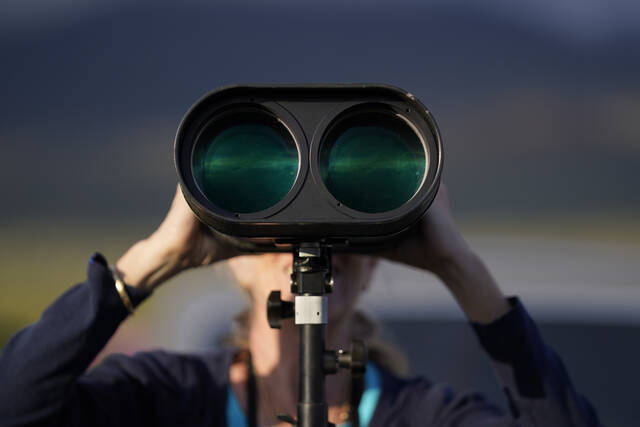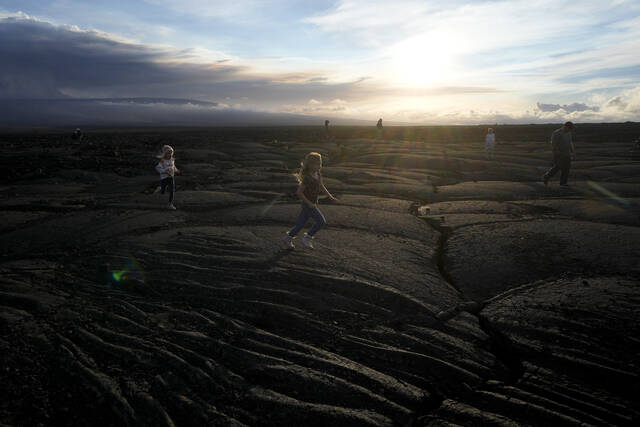Hawaii volcano's lava oozes toward key Big Island highway
KAILUA-KONA, Hawaii — Rivers of glowing lava oozing from the world’s largest volcano could swallow the main highway linking the east and west coasts of Hawaii’s Big Island as early as this weekend, and there’s nothing humans can do to stop it, experts said.
Mauna Loa awoke from its 38-year slumber Sunday, spewing volcanic ash and debris into the sky. The molten rock is drawing thousands of awestruck viewers to Route 200 as it passes near Volcanoes National Park, and they endure a thick smell of volcanic gases and sulfur to watch the wide stream of lava creep closer.
“It’s a thrill,” said Kathryn Tarananda, 66, of Waimea. She set two alarms to make sure she didn’t miss her chance to see the eruptions at sunrise. “We’re out in the middle of raw nature. It’s awe inspiring that we live in this place. … I feel really, really fortunate to be an islander.”
The lava tumbling slowly down the slope has drawn within several miles of the highway, which runs through old lava flows. Known as Saddle Road, it bisects the island, connecting the cities of Hilo and Kailua-Kona. If it becomes impassable, the alternative is a longer coastal road, adding several hours of driving time.
Ken Hon, scientist in charge at the Hawaiian Volcano Observatory, said Wednesday that at the current flow rate, the lava could reach the road in as little as two days, though it will likely take longer. “As the lava flow spreads out, it will probably interfere with its own progress,” Hon said.
Lava crossed the Mauna Loa Observatory access road Monday night and cut off its power, Hon said. It’s the world’s premier station that measures heat-trapping carbon dioxide in the atmosphere. The federal government is looking for a temporary alternate site on the Hawaiian island and is contemplating flying a generator to the observatory to get its power back so it can take measurements again.
Meanwhile, scientists are trying to measure the gas emitted from the eruption.
Anne Andersen left her overnight shift as a nurse to see the spectacle Wednesday, afraid the road would soon be closed.
“It’s Mother Nature showing us her face,” she said, as the volcano belched gas on the horizon. “It’s pretty exciting.”
Gordon Brown, visiting from Loomis, California, could see the bright orange lava from the bedroom of his rental house, so he and his wife went out for a closer view. “It is so bright, it just blows my mind,” Brown said.
Mauna Loa last erupted in 1984. The current eruption is its 34th since written record keeping began in 1843. Its smaller neighbor, Kilauea, has been erupting since September 2021, so visitors to the national park were treated to the rare sight of two simultaneous eruptive events: the glow from Kilauea’s lava lake and lava from a Mauna Loa fissure.
Officials were initially concerned that lava flowing down Mauna Loa would head toward the community of South Kona, but scientists later assured the public the eruption had migrated to a rift zone on the volcano’s northeast flank and wasn’t threatening communities.
Gov. David Ige has issued an emergency proclamation to allow responders to arrive quickly or limit access as needed. He’s dealt with multiple volcanic eruptions during his eight years as governor, and said it’s impossible to redirect the glowing rock.
“There is no physical way or technological way to change the course of where the lava flows,” Ige told a news conference, recalling how many wished it was possible in 2018, when Kilauea sent lava pouring across homes, farms and roads.
“The power of Mother Nature and Madam Pele overwhelms anything that we can do,” Ige said, referring to the Hawaiian deity of volcanoes and fire.
If lava does cross the highway, the Hawaii National Guard can help plan for alternatives and try to set up bypass routes, the governor said.
Remove the ads from your TribLIVE reading experience but still support the journalists who create the content with TribLIVE Ad-Free.






